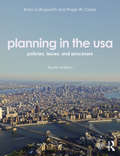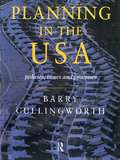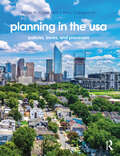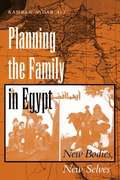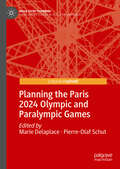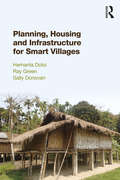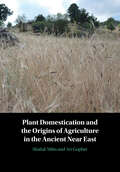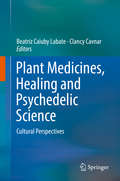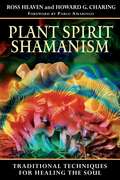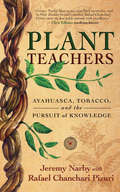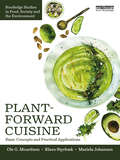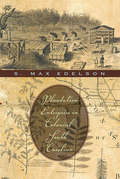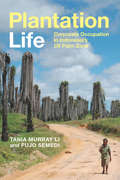- Table View
- List View
Planning in the Soviet Union (Routledge Revivals)
by Judith Pallot Denis J. ShawOriginally published in 1981 and based on the authors’ own research, this book provides a comprehensive review of planning in the Soviet Union up until the early 1980s for both geographers and Soviet specialists. Planning was particularly important in the Soviet Union since not only most spatial change, but all economic planning was the product of a systematic socio-political ideology. Planning was therefore the key to understanding the Soviet economy, society and spatial change. When it was first published, this was the first study in which the focus had been directed specifically at spatial planning in the Soviet Union in any systematic way.
Planning in the USA
by Roger Caves J. Barry CullingworthThis extensively revised and updated fourth edition of Planning in the USA continues to provide a comprehensive introduction to the policies, theory and practice of planning. Outlining land use, urban planning, and environmental protection policies, this fully illustrated book explains the nature of the planning process and the way in which policy issues are identified, defined, and approached. This full colour edition incorporates new planning legislation and regulations at the state and federal layers of government, updated discussion on current economic issues, and examples of local ordinances in a variety of planning areas. Key updates include: a new chapter on planning and sustainability; a new discussion on the role of foundations and giving to communities; a discussion regarding the aftermath of Katrina in New Orleans; a discussion on deindustrialization and shrinking cities; a discussion on digital billboards; a discussion on recent comprehensive planning efforts; a discussion on land banking; a discussion unfunded mandates; a discussion on community character; a companion website with multiple choice and fill the blank questions, and 'test yourself' glossary terms. This book gives a detailed account of urbanization in the United States and reveals the problematic nature and limitations of the planning process, the fallibility of experts, and the difficulties facing policy-makers in their search for solutions. Planning in the USA is an essential book for students, planners and all who are concerned with the nature of contemporary urban and environmental problems.
Planning in the USA: Policies, Issues and Processes
by Barry CullingworthPlanning in the USA is a comprehensive introduction to the policies, theory and practice of planning. outlining land use, urban planning and environmental protection policies, this fully illustrated book explains the nature of the planning process and the way in which policy issues are identified, defined and approached.Planning in the USA offers a detailed account of urbanization in the USA. Focussing on policies relating to land use, urban planning and environmental protection, Barry Cullingworth reveals the problematic nature and limitations of the planning process, the fallibility of experts, and difficulties facing policy-makers in their search for solutions.Coverage includes:Land Use Regulation Transport, Housing and Community Development Public Attitudes to Planning Property Rights Environmental Planning and PoliciesGrowth Management Planning and Governance Planning problems are seldom easily solved. Barry Cullingworth's Planning in the USA is an essential book for students and planners and all who are concerned with the nature of contemporary urban and environmental problems.
Planning in the USA: Policies, Issues, and Processes
by J. Barry Cullingworth Roger W. CavesExtensively revised and updated, Planning in the USA, fifth edition, continues to provide a comprehensive introduction to the policies, theory, and practice of planning. Outlining land use, urban planning, and environmental protection policies, this fully illustrated book explains the nature of the planning process and the way in which policy issues are identified, defined, and approached. The new edition incorporates new planning legislation and regulations at the state and federal layers of government and examples of local ordinances in a variety of planning areas. New material includes discussions of • education and equity in planning; • the City Beautiful Movement; • Daniel Burnham’s plan for Chicago; • segregation; • Knick v. Township of Scott; • reforming single-family zoning and regulatory challenges in zoning and land use; • Daniel Parolek’s ‘Missing Middle Housing’; • climate change, mitigation, adaptation, and resiliency; • the drinking water crisis in Flint, Michigan; • sharing programs for cars, bicycles, and scooters; • hybrid electric and autonomous vehicles; • Vision Zero; • COVID-19 relief for housing; • Innovation Districts, Promise Zones, and Opportunity Zones; • the sharing, gig, and creative economies; • scenic views and vistas, monuments, statues, and remembering the past; and • healthy cities, Health Impact Assessment, and active living. This detailed account of urbanization in the United States reveals the problematic nature and limitations of the planning process, the fallibility of experts, and the difficulties facing policy-makers in their search for solutions. Planning in the USA, fifth edition, is an essential book for students of urban planning, urban politics, environmental geography, and environment politics. It will be a valuable resource for planners and all who are concerned with the nature of contemporary urban and environmental problems.
Planning the Family in Egypt: New Bodies, New Selves
by Kamran Asdar AliIn this ethnographic study, the author examines the policies and practices of family planning programs in Egypt to see how an elitist, Western-informed state attempts to create obliging citizens. The state sees voluntary compliance with the law for the common good as the cornerstone of modernity. Family planning programs are a training ground for the construction of self-disciplined individuals, and thus a rewarding area of study for the fate of social programs in developing countries.
Planning the Paris 2024 Olympic and Paralympic Games (Mega Event Planning)
by Marie Delaplace Pierre-Olaf SchutThis book is the first volume to provide a comprehensive account of mega-event planning for the Paris 2024 Olympic and Paralympic Games. It offers a useful summary of the themes and debates relating to urban planning for the Paris Olympics, based on the results of a research programme (Observatory for Research on Mega-Event) funded by Gustave Eiffel University and Paris Est University and partly carried out with the organisers of the Games and their stakeholders. The authors address all aspects of the bidding process, the organisation of the Games and the construction of the social legacy of the Games.
Planning, Housing and Infrastructure for Smart Villages
by Sally Donovan Ray Green Hemanta DoloiSome 7.3 billion people currently live on the planet. Of these, 3.4 billion live in rural areas. In just a few regions—Latin America, the Middle East and North Africa—less than 50 per cent of poverty is now located in rural areas. But for the rest of the world's regions between 55 per cent and 80 per cent of the poor continue to live in the countryside. Progress is being made, but much of the knowhow needed is not disseminated outside of a small coterie of professionals who work in the area. With urban development attracting a great deal of attention lately, poorer rural areas deserve the same and new knowledge for empowerment of rural communities is urgently needed. This book provides an overview of current thinking and practices that have emerged over the last thirty years for uplifting rural communities in developing economies. Drawing on a body of knowledge across a spectrum of relevant disciplines, this book provides a range of innovative ideas for rural planning, housing and infrastructure development. Governments in many emerging economies, where rural poverty is often most acute, have attempted to improve livelihoods. Approaches and techniques that have been used for urban development are often not applicable to rural communities. Studies show that money allocated for rural development is often not effectively spent due to distance, lack of infrastructure, lack of education, poverty and other factors. Meanwhile, the gap in development between the city and country continues to grow, sometimes leading to social and political instability, in both developing and developed countries. This book seeks to provide a guidebook for meeting such challenges. Through in-depth enquiry of global practices and thinking about rural development, and selected case studies, the authors argue that careful consideration must be given to incorporating issues of resilience, resourcefulness and the involvement of communities at grassroots levels in realising the transformation of rural settlements into Smart Villages.
Plans and Provisions for the Mentally Handicapped (National Institute Social Services Library)
by Bernie Spain Margaret Bone F. M. MartinThe lack of good statistical information had been a major factor in the poor planning of services for the mentally handicapped in the late 1960s. The principal object of this book was to provide an accurate factual basis for the planning of future services. Originally published in 1972, this title is based on three years’ extensive research and consists primarily of statistical studies rather than case studies. There is a survey of facilities provided by hospitals for the mentally handicapped and a sample survey of three Hospital Regions indicating the characteristics and disabilities of the mentally handicapped inpatients. Also included are two cohort studies, one of the subsequent experience of patients after their first admittance to a hospital, and one of the subsequent experience of all first referrals to a Local Authority service. Both studies were carried out to determine trends in the patterns of care. This was the first time that cohort techniques had been applied in this field in this country. Since effective long-term planning depends upon the coordination of the work of Local Authorities and hospitals, it is unrealistic to divorce the need for hospital beds from community provision. This book, therefore, examined the present services for the mentally handicapped in the round. It is supplemented by an extensive bibliography and numerous tables and diagrams. As a result, it should be of particular interest to psychiatrists, clinical psychologists, hospital administrators, senior nursing staff and Local Authority social service administrators. This book is a re-issue originally published in 1972. The language used is reflective of its era and no offence is meant by the Publishers to any reader by this re-publication.
Plant Domestication and the Origins of Agriculture in the Ancient Near East
by Shahal Abbo Avi Gopher Gila Kahila Bar-GalThe Agricultural Revolution – including the domestication of plants and animals in the Near East – that occurred 10,500 years ago ended millions of years of human existence in small, mobile, egalitarian communities of hunters-gatherers. This Neolithic transformation led to the formation of sedentary communities that produced crops such as wheat, barley, peas, lentils, chickpeas and flax and domesticated range of livestock, including goats, sheep, cattle and pigs. All of these plants and animals still play a major role in the contemporary global economy and nutrition. This agricultural revolution also stimulated the later development of the first urban centres. This volume examines the origins and development of plant domestication in the Ancient Near East, along with various aspects of the new Man-Nature relationship that characterizes food-producing societies. It demonstrates how the rapid, geographically localized, knowledge-based domestication of plants was a human initiative that eventually gave rise to Western civilizations and the modern human condition.
Plant Hunter In Tibet
by Frank Kingdom-WardFirst published in 2006. Routledge is an imprint of Taylor & Francis, an informa company.
Plant Medicines, Healing and Psychedelic Science: Cultural Perspectives
by Beatriz Caiuby Labate Clancy CavnarThis is a book about the intersections of three dimensions. The first is the way social scientists and historians treat the history of psychiatry and healing, especially as it intersects with psychedelics. The second encompasses a reflection on the substances themselves and their effects on bodies. The third addresses traditional healing, as it circles back to our understanding of drugs and psychiatry. The chapters explore how these dimensions are distinct, but deeply intertwined, themes that offer important insights into contemporary healing practices.The intended audience of the volume is large and diverse: neuroscientists, biologists, medical doctors, psychiatrists, psychologists; mental health professionals interested in the therapeutic application of psychedelic substances, or who work with substance abuse, depression, anxiety, and PTSD; patients and practitioners of complementary and alternative medicine; ethnobotanists and ethnopharmacologists; lawyers, criminologists, and other specialists in international law working on matters related to drug policy and human rights, as well as scholars of religious studies, anthropologists, sociologists, and historians; social scientists concerned both with the history of science, medicine, and technology, and concepts of health, illness, and healing. It has a potentially large international audience, especially considering the increasing interest in “psychedelic science” and the growing spread of the use of traditional psychoactives in the West.
Plant Spirit Shamanism: Traditional Techniques for Healing the Soul
by Pablo Amaringo Ross Heaven Howard G. CharingAn in-depth look at the role of plant spirits in shamanic rituals from around the world • Shows how shamans heal using their knowledge of plant spirits as well as the plant’s “medical properties” • Explores the core methods of plant shamanism--soul retrieval, spirit extraction, and sin eating--and includes techniques for connecting with plant spirits • Includes extensive field interviews with master shamans of all traditions In Plant Spirit Shamanism, Ross Heaven and Howard G. Charing explore the use of one of the major allies of shamans for healing, seeing, dreaming, and empowerment--plant spirits. After observing great similarities in the use of plants among shamans throughout the world, they discovered the reason behind these similarities: Rather than dealing with the “medical properties” of the plants or specific healing techniques, shamans commune with the spirits of the plants themselves. From their years of in-depth shamanic work in the Amazon, Haiti, and Europe, including extensive field interviews with master shamans, Heaven and Charing present the core methods of plant shamanism used in healing rituals the world over: soul retrieval, spirit extraction, sin eating, and the Amazonian tradition of pusanga (love medicine). They explain the techniques shamans use to establish connections to plant spirits and provide practical exercises as well as a directory of traditional Amazonian and Caribbean healing plants and their common North American equivalents so readers can ex-plore the world of plant spirits and make allies of their own.
Plant Teachers: Ayahuasca, Tobacco, and the Pursuit of Knowledge
by Jeremy NarbyA trailblazing anthropologist and an indigenous Amazonian healer explore the convergence of science and shamanism &“The dose makes the poison,&” says an old adage, reminding us that substances have the potential to heal or to harm, depending on their use. Although Western medicine treats tobacco as a harmful addictive drug, it is considered medicinal by indigenous people of the Amazon rainforest. In its unadulterated form, it holds a central place in their repertoire of traditional medicines. Along with ayahuasca, tobacco forms a part of treatments designed to heal the body, stimulate the mind, and inspire the soul with visions. In Plant Teachers, anthropologist Jeremy Narby and traditional healer Rafael Chanchari Pizuri hold a cross-cultural dialogue that explores the similarities between ayahuasca and tobacco, the role of these plants in indigenous cultures, and the hidden truths they reveal about nature. Juxtaposing and synthesizing two worldviews, Plant Teachers invites readers on a wide-ranging journey through anthropology, botany, and biochemistry, while raising tantalizing questions about the relationship between science and other ways of knowing.
Plant Theory in Amazonian Literature (New Directions in Latino American Cultures)
by Juan R. Duchesne WinterThis book discusses new developments of plant studies and plant theory in the humanities and compares them to the exceptionally robust knowledge about plant life in indigenous traditions practiced to this day in the Amazonian region. Amazonian thinking, in dialogue with the thought of Eduardo Viveiros de Castro, Emanuele Coccia and others, can serve to bring plant theory in the humanities beyond its current focus on how the organic existence of plants is projected into culture. Contemporary Amazonian indigenous literature takes us beyond conventional theory and into the unsuspected reaches of vegetal networks. It shows that what matters about plants are not just their strictly biological and ecological projections, but the manner in which they interact with multiple species and cultural actors in continuously shifting bodies and points of view, by becoming-other, and fashioning a natural and social diplomacy in which humans participate along with non-humans.
Plant-Forward Cuisine: Basic Concepts and Practical Applications (Routledge Studies in Food, Society and the Environment)
by Ole G. Mouritsen Klavs Styrbæk Mariela JohansenPlant-Forward Cuisine is a beautifully illustrated book that promotes the environmental and health benefits of a plant-forward diet and will inspire readers with a range of exciting recipes.The book addresses the urgent need to make changes to those culinary cultures where animal-sourced proteins play a central role. To ensure that there is enough food for a growing world population, to lessen the burden on the environment, and to promote healthier, sustainable eating patterns, it is crucial to transition to a diet that focuses primarily on plants as the key ingredients. Yet, many people dislike the taste of plants because of their texture and lack of sweetness and umami. Luckily, the book provides a solution to these challenges. It offers key scientific descriptions of the physical characteristics of plants, mushrooms, algae, and fungi and their nutritional components, along with information about creation of texture and flavour. Armed with this knowledge, the recipes then provide tips and tricks for transforming plants into delicious meals with pleasing textures and flavours. The authors stress that it is not necessary to embrace a fully vegetarian or vegan diet. Rather, they suggest that taking a flexitarian approach, which incorporates small quantities of animal products to elicit umami, may be a more viable and lasting solution for people at large. Throughout the text readers will find interesting narratives about various aspects of green gastronomy around the world. The book concludes with two helpful reference sections: a glossary of main ingredients used in the recipes and a compilation of ingredients that can be used to add taste and aroma.This book will be of great interest to those concerned with building a sustainable food system, and it will serve as a practical guide for those seeking to transition to plant-rich diets without compromising their taste experience and enjoyment of food.
Plantation Enterprise in Colonial South Carolina
by S. Max EdelsonThis impressive scholarly debut deftly reinterprets one of America's oldest symbols--the southern slave plantation. S. Max Edelson examines the relationships between planters, slaves, and the natural world they colonized to create the Carolina Lowcountry. European settlers came to South Carolina in 1670 determined to possess an abundant wilderness. Over the course of a century, they settled highly adaptive rice and indigo plantations across a vast coastal plain. Forcing slaves to turn swampy wastelands into productive fields and to channel surging waters into elaborate irrigation systems, planters initiated a stunning economic transformation. The result, Edelson reveals, was two interdependent plantation worlds. A rough rice frontier became a place of unremitting field labor. With the profits, planters made Charleston and its hinterland into a refined, diversified place to live. From urban townhouses and rural retreats, they ran multiple-plantation enterprises, looking to England for affirmation as agriculturists, gentlemen, and stakeholders in Britain's American empire. Offering a new vision of the Old South that was far from static, Edelson reveals the plantations of early South Carolina to have been dynamic instruments behind an expansive process of colonization. With a bold interdisciplinary approach, Plantation Enterprise reconstructs the environmental, economic, and cultural changes that made the Carolina Lowcountry one of the most prosperous and repressive regions in the Atlantic world.
Plantation Goods: A Material History of American Slavery
by Seth RockmanAn eye-opening rethinking of nineteenth-century American history that reveals the interdependence of the Northern industrial economy and Southern slave labor. The industrializing North and the agricultural South—that’s how we have been taught to think about the United States in the early nineteenth century. But in doing so, we overlook the economic ties that held the nation together before the Civil War. We miss slavery’s long reach into small New England communities, just as we fail to see the role of Northern manufacturing in shaping the terrain of human bondage in the South. Using plantation goods—the shirts, hats, hoes, shovels, shoes, axes, and whips made in the North for use in the South—historian Seth Rockman locates the biggest stories in American history in the everyday objects that stitched together the lives and livelihoods of Americans—white and Black, male and female, enslaved and free—across an expanding nation. By following the stories of material objects, such as shoes made by Massachusetts farm women that found their way to the feet of a Mississippi slave, Rockman reveals a national economy organized by slavery—a slavery that outsourced the production of its supplies to the North, and a North that outsourced its slavery to the South. Melding business and labor history through powerful storytelling, Plantation Goods brings northern industrialists, southern slaveholders, enslaved field hands, and paid factory laborers into the same picture. In one part of the country, entrepreneurs envisioned fortunes to be made from “planter’s hoes” and rural women spent their days weaving “negro cloth” and assembling “slave brogans.” In another, enslaved people actively consumed textiles and tools imported from the North to contest their bondage. In between, merchants, marketers, storekeepers, and debt collectors laid claim to the profits of a thriving interregional trade. Examining producers and consumers linked in economic and moral relationships across great geographic and political distances, Plantation Goods explores how people in the nineteenth century thought about complicity with slavery while showing how slavery structured life nationwide and established a modern world of entrepreneurship and exploitation. Rockman brings together lines of American history that have for too long been told separately, as slavery and capitalism converge in something as deceptively ordinary as a humble pair of shoes.
Plantation Kingdom: The American South and Its Global Commodities (The Marcus Cunliffe Lecture Series)
by Sven Beckert Richard Follett Barbara M. Hahn Peter CoclanisHow global competition brought the plantation kingdom to its knees.In 1850, America’s plantation economy reigned supreme. U.S. cotton dominated world markets, and American rice, sugarcane, and tobacco grew throughout a vast farming empire that stretched from Maryland to Texas. Four million enslaved African Americans toiled the fields, producing global commodities that enriched the most powerful class of slaveholders the world had ever known. But fifty years later—after emancipation demolished the plantation-labor system, Asian competition flooded world markets with cheap raw materials, and free trade eliminated protected markets—America’s plantations lay in ruins.Plantation Kingdom traces the rise and fall of America’s plantation economy. Written by four renowned historians, the book demonstrates how an international capitalist system rose out of slave labor, indentured servitude, and the mass production of agricultural commodities for world markets. Vast estates continued to exist after emancipation, but tenancy and sharecropping replaced slavery’s work gangs across most of the plantation world. Poverty and forced labor haunted the region well into the twentieth century.The book explores the importance of slavery to the Old South, the astounding profitability of plantation agriculture, and the legacy of emancipation. It also examines the place of American producers in world markets and considers the impact of globalization and international competition 150 years ago. Written for scholars and students alike, Plantation Kingdom is an accessible and fascinating study.
Plantation Life: Corporate Occupation in Indonesia's Oil Palm Zone
by Tania Murray Li Pujo SemediIn Plantation Life Tania Murray Li and Pujo Semedi examine the structure and governance of Indonesia's contemporary oil palm plantations in Indonesia, which supply 50 percent of the world's palm oil. They attend to the exploitative nature of plantation life, wherein villagers' well-being is sacrificed in the name of economic development. While plantations are often plagued by ruined ecologies, injury among workers, and a devastating loss of livelihoods for former landholders, small-scale independent farmers produce palm oil more efficiently and with far less damage to life and land. Li and Semedi theorize “corporate occupation” to underscore how massive forms of capitalist production and control over the palm oil industry replicate colonial-style relations that undermine citizenship. In so doing, they question the assumption that corporations are necessary for rural development, contending that the dominance of plantations stems from a political system that privileges corporations.
Plantation Memories: Episodes of Everyday Racism
by Grada KilombaPlantation Memories is a compilation of episodes of everyday racism written in the form of short psychoanalytical stories. From the question “Where do you come from?” to Hair Politics to the N-word, the book is a strong, eloquent, and elaborate piece that deconstructs the normality of everyday racism and exposes the violence of being placed as the Other. Released at the Berlin International Literature Festival in 2008, soon the book became internationally acclaimed and part of numerous academic curricula. Known for her subversive practice of giving body, voice, and image to her own texts, Grada Kilomba has adapted her book into a staged reading and video installation. Plantation Memories is an important contribution to the global cultural discourse.
Plantation Pedagogy: The Violence of Schooling across Black and Indigenous Space (American Crossroads #72)
by Bayley J. MarquezThroughout the nineteenth and twentieth centuries, teachers, administrators, and policymakers fashioned a system of industrial education that attempted to transform Black and Indigenous peoples and land. This form of teaching—what Bayley J. Marquez names plantation pedagogy—was built on the claim that slavery and land dispossession are fundamentally educational. Plantation pedagogy and the formal institutions that encompassed it were thus integrally tied to enslavement, settlement, and their inherent violence toward land and people. Marquez investigates how proponents developed industrial education domestically and then spread the model abroad as part of US imperialism. A deeply thoughtful and arresting work, Plantation Pedagogy sits where Black and Native studies meet in order to understand our interconnected histories and theorize our collective futures.
Plantation Worlds
by Maan BaruaIn Plantation Worlds, Maan Barua interrogates debates on planetary transformations through the histories and ecologies of plantations. Drawing on long-term research spanning fifteen years, Barua presents a unique ethnography attentive to the lives of both people and elephants amid tea plantations in the Indian state of Assam. In the nineteenth and early twentieth centuries, nearly three million people were brought in to Assam’s plantations to work under conditions of indenture. Plantations dramatically altered the region’s landscape, plundered resources, and created fraught worlds for elephants and people. Their extractive logics and colonial legacies prevail as durations, forging the ambit of infrastructures, labor, habitability, and conservation in the present. And yet, as the perspectives of the Adivasi plantation worker community and lifeworlds of elephants show, possibilities for enacting a decolonial imaginary of landscape remain present amid immiseration. From the margins of the Global South, Barua offers an alternative grammar for articulating environmental change. In so doing, he prompts a rethinking of multispecies ecologies and how they are structured by colonialism and race.
Plantations, Proletarians and Peasants in Colonial Asia
by Tom Brass E. Valentine Daniel Henry BernsteinThis volume originated in a conference on 'Capitalist Plantations in Colonial Asia', held at the Centre for Asian Studies of the University of Amsterdam and Free University of Amsterdam in September 1990. The contributions to this collection focus on the production of rubber, sugar, tea, and several less strategic plantation crops, in colonial Indochina, Java, Malaya, the Philippines, India, Ceylon, Mauritius and Fiji (although geographically anomalous, both the latter are included because of the centrality to their sugar plantations of indentured labour from India).
Planters, Merchants, and Slaves: Plantation Societies in British America, 1650-1820 (American Beginnings, 1500–1900)
by Trevor BurnardAs with any enterprise involving violence and lots of money, running a plantation in early British America was a serious and brutal enterprise. Beyond resources and weapons, a plantation required a significant force of cruel and rapacious men--men who, as Trevor Burnard sees it, lacked any better options for making money. In the contentious Planters, Merchants, and Slaves, Burnard argues that white men did not choose to develop and maintain the plantation system out of virulent racism or sadism, but rather out of economic logic because--to speak bluntly--it worked. These economically successful and ethically monstrous plantations required racial divisions to exist, but their successes were always measured in gold, rather than skin or blood. Burnard argues that the best example of plantations functioning as intended is not those found in the fractious and poor North American colonies, but those in their booming and integrated commercial hub, Jamaica. Sure to be controversial, this book is a major intervention in the scholarship on slavery, economic development, and political power in early British America, mounting a powerful and original argument that boldly challenges historical orthodoxy.
Planting Parliaments in Eurasia, 1850–1950: Concepts, Practices, and Mythologies (Routledge Studies in the Modern History of Asia)
by Ivan Sablin and Egas Moniz BandeiraParliaments are often seen as Western European and North American institutions and their establishment in other parts of the world as a derivative and mostly defective process. This book challenges such Eurocentric visions by retracing the evolution of modern institutions of collective decision-making in Eurasia. Breaching the divide between different area studies, the book provides nine case studies covering the area between the eastern edge of Asia and Eastern Europe, including the former Russian, Ottoman, Qing, and Japanese Empires as well as their successor states. In particular, it explores the appeals to concepts of parliamentarism, deliberative decision-making, and constitutionalism; historical practices related to parliamentarism; and political mythologies across Eurasia. It focuses on the historical and “reestablished” institutions of decision-making, which consciously hark back to indigenous traditions and adapt them to the changing circumstances in imperial and postimperial contexts. Thereby, the book explains how representative institutions were needed for the establishment of modernized empires or postimperial states but at the same time offered a connection to the past.

